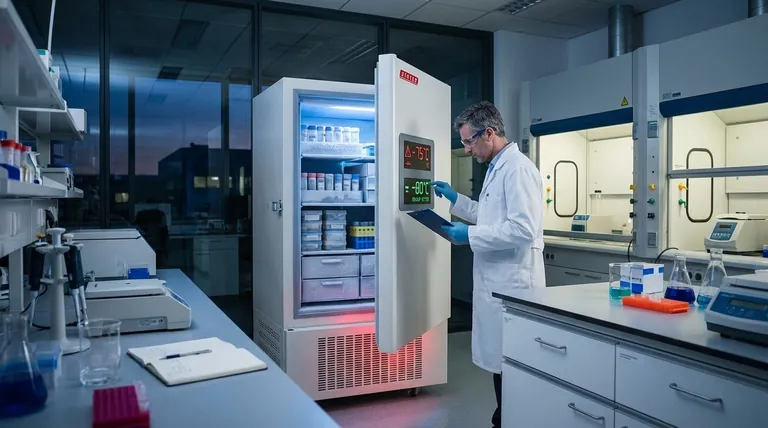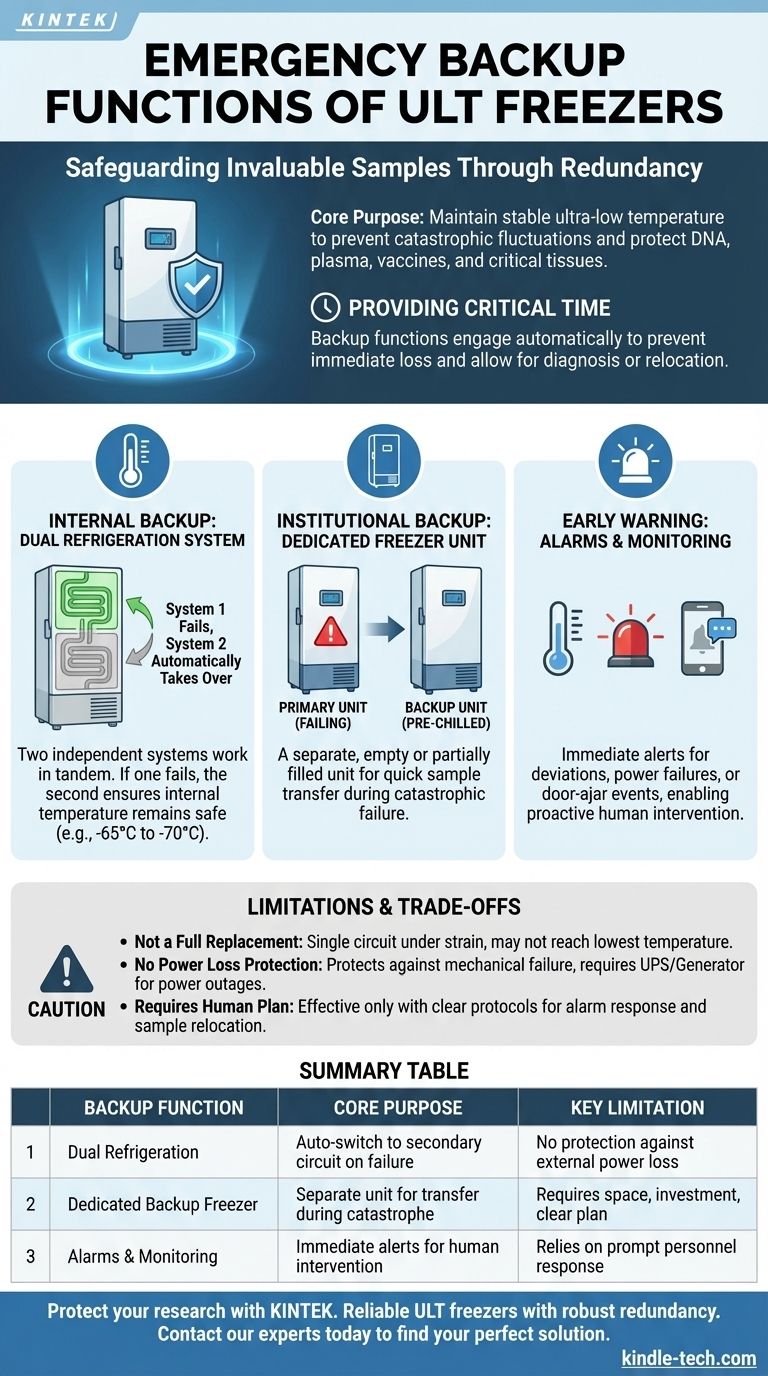The emergency backup function of a ULT freezer refers to its internal redundant systems designed to maintain a stable, ultra-low temperature even if a primary component fails. This is most commonly achieved through a dual refrigeration system, which ensures the integrity of invaluable biological and chemical samples by preventing catastrophic temperature fluctuations.
The core purpose of a ULT freezer's emergency functions is to provide time. By automatically engaging a secondary system during a component failure, it prevents immediate sample loss and gives personnel a critical window to diagnose the issue or arrange for sample relocation.

The Core Principle: Redundancy for Sample Protection
Ultra-Low Temperature (ULT) freezers store materials that are often invaluable or irreplaceable, such as DNA, plasma, vaccines, and critical research tissues.
The entire design philosophy is built around preventing temperature deviations that could destroy decades of work or compromise life-saving medical products. The backup functions are a direct result of this high-stakes requirement.
Unpacking the Emergency Backup Functions
While the term "backup" can mean different things, in the context of a single ULT freezer's features, it primarily refers to hardware redundancy.
The Dual Refrigeration System
This is the most critical internal backup feature. Instead of one large refrigeration circuit, the freezer is equipped with two independent systems.
These systems work in tandem to efficiently maintain the target temperature, typically around -80°C.
If one of the refrigeration systems fails due to a compressor malfunction or a refrigerant leak, the second system automatically takes over. It continues to run, ensuring the internal temperature remains at a safe, ultra-low level.
The Freezer as a Backup Unit
On a broader, institutional level, entire ULT freezers serve as emergency backups.
Many labs maintain a dedicated backup ULT freezer that is either empty or partially filled with non-critical samples. In the event of a catastrophic failure of a primary unit—one that its internal backups cannot handle—samples can be quickly transferred to this designated backup unit.
Alarms and Monitoring
While not a mechanical backup, the alarm system is a crucial part of any emergency protocol.
These systems provide immediate alerts for temperature deviations, power failures, or door-ajar events. This allows personnel to intervene long before the internal temperature rises to a critical point, turning a potential disaster into a manageable event.
Understanding the Limitations and Trade-offs
A backup system provides a safety net, but it's essential to understand its limitations to form a complete emergency plan.
It's a Lifeline, Not a Full Replacement
When a dual refrigeration system is running on only one circuit, it is under significant strain.
It may not be able to maintain the absolute lowest temperature setting (e.g., -86°C), but it will hold a safe temperature like -65°C or -70°C. This is more than enough to protect samples, but it signals an urgent need for service.
Internal Backups vs. Power Failure
A dual refrigeration system protects against internal mechanical failure, not external power loss.
If the facility's power goes out, the freezer cannot run unless it is connected to an Uninterruptible Power Supply (UPS) for short-term protection or, more importantly, a backup generator for extended outages.
Technology Requires a Human Plan
The freezer's features are only effective as part of a larger emergency preparedness plan. This plan must dictate who receives alarm notifications, what the standard procedure is for a failure, and where samples should be moved in a worst-case scenario.
Making the Right Choice for Your Goal
To ensure your samples are secure, you must align the freezer's capabilities with your lab's overall emergency strategy.
- If your primary focus is maximum uptime: Select a ULT freezer with a proven dual refrigeration system to mitigate the risk of a single-point mechanical failure.
- If your primary focus is disaster preparedness: Designate a separate, dedicated backup freezer unit and establish a clear, documented plan for transferring critical samples in an emergency.
- If your primary focus is proactive intervention: Ensure your freezer's alarm system is connected to a remote notification service and that the unit is powered by a circuit connected to your building's backup generator.
Understanding these layers of protection is the key to ensuring your critical samples remain secure through any potential equipment failure.
Summary Table:
| Backup Function | Core Purpose | Key Limitation |
|---|---|---|
| Dual Refrigeration System | Automatically switches to a secondary cooling circuit if the primary fails. | Does not protect against external power loss. |
| Dedicated Backup Freezer | Provides a separate, pre-chilled unit for sample transfer during catastrophic failure. | Requires space, investment, and a clear transfer plan. |
| Alarms & Monitoring | Provides immediate alerts for temperature deviations, enabling human intervention. | Relies on personnel to respond promptly to notifications. |
Protect your invaluable research and clinical samples with confidence. The emergency backup functions in a ULT freezer are your first line of defense against catastrophic sample loss. At KINTEK, we specialize in providing reliable laboratory equipment, including ULT freezers with robust redundancy features, to meet the critical needs of research, clinical, and biobanking facilities.
Don't leave your samples to chance. Contact our experts today to find the perfect ULT freezer solution for your lab's specific security requirements.
Visual Guide

Related Products
- 108L Vertical Ultra Low Temperature ULT Freezer
- 938L Vertical Ultra Low Temperature Freezer for Advanced Laboratory Storage
- 158L Precision Vertical Ultra Low Freezer for Laboratory Applications
- 608L Essential Laboratory Ultra Low Temperature Freezer For Critical Sample Preservation
- 708L Ultra Low Temperature Freezer High Performance Laboratory Freezer
People Also Ask
- What advantages do ultra-low temperature freezers offer? Ensure Long-Term Sample Integrity and Reliability
- What are the common applications of ultra-low temperature freezers? Preserve Your Most Valuable Samples
- What temperature range do Ultra-Low Temperature freezers maintain? The -80°C Standard for Sample Integrity
- What makes Ultra-Low Temperature freezers energy efficient? Key Design & Operational Strategies
- How do Ultra-Low Temperature freezers ensure the integrity of microbiological samples? Maintain Stability for Critical Research



















